Boltzmann equation - Study guides, Class notes & Summaries
Looking for the best study guides, study notes and summaries about Boltzmann equation? On this page you'll find 64 study documents about Boltzmann equation.
Page 3 out of 64 results
Sort by
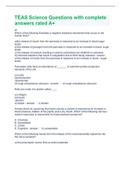
-
TEAS Science Questions with complete answers rated A+
- Exam (elaborations) • 35 pages • 2023
- Available in package deal
-
- $11.99
- + learn more
TEAS Science Questions with complete answers rated A+ Which of the following illustrates a negative feedback mechanism that occurs in the human body? a)the release of insulin from the pancreas in response to an increase in blood sugar levels b) the release of glucagon from the pancreas in response to an increase in blood- sugar levels c) the release of oxytocin resulting in uterine contractions as childbirth is underway d) chemical reactions that result in coagulation due to fibrin being ...
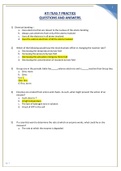
-
ATI TEAS 7 PRACTICE QUESTIONS AND ANSWERS LATEST TEST
- Exam (elaborations) • 48 pages • 2023
-
- $16.49
- + learn more
ATI TEAS 7 PRACTICE QUESTIONS AND ANSWERS. 1) Chemical bonding – a. Uses electrons that are closest to the nucleus of the atoms bonding b. Always uses electrons from only of the atoms involved c. Uses all the electrons in all atoms involved d. Uses the valence electrons of all the atoms involved 2) Which of the following would have the most dramatic effect in changing the reaction rate? a. Decreasing the temperature by two-fold b. Increasing the pressure by two-fold c. Decreasin...
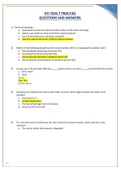
-
ATI TEAS 7 PRACTICE QUESTIONS AND ANSWERS LATEST 2023/2024
- Exam (elaborations) • 48 pages • 2023
-
- $16.69
- + learn more
ATI TEAS 7 PRACTICE QUESTIONS AND ANSWERS. 1) Chemical bonding – a. Uses electrons that are closest to the nucleus of the atoms bonding b. Always uses electrons from only of the atoms involved c. Uses all the electrons in all atoms involved d. Uses the valence electrons of all the atoms involved 2) Which of the following would have the most dramatic effect in changing the reaction rate? a. Decreasing the temperature by two-fold b. Increasing the pressure by two-fold c. Decreasin...
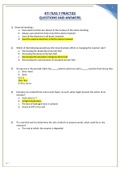
-
ATI TEAS 7 PRACTICE QUESTIONS AND ANSWERS
- Exam (elaborations) • 48 pages • 2023
-
- $16.99
- + learn more
ATI TEAS 7 PRACTICE QUESTIONS AND ANSWERS. 1) Chemical bonding – a. Uses electrons that are closest to the nucleus of the atoms bonding b. Always uses electrons from only of the atoms involved c. Uses all the electrons in all atoms involved d. Uses the valence electrons of all the atoms involved 2) Which of the following would have the most dramatic effect in changing the reaction rate? a. Decreasing the temperature by two-fold b. Increasing the pressure by two-fold c. Decreasin...
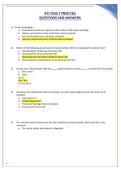
-
ATI TEAS 7 Practice Questions and Answers Chemistry (Best Guide for Teas 7 prep)
- Exam (elaborations) • 48 pages • 2023
-
- $11.49
- + learn more
ATI TEAS 7 PRACTICE QUESTIONS AND ANSWERS. 1) Chemical bonding – a. Uses electrons that are closest to the nucleus of the atoms bonding b. Always uses electrons from only of the atoms involved c. Uses all the electrons in all atoms involved d. Uses the valence electrons of all the atoms involved 2) Which of the following would have the most dramatic effect in changing the reaction rate? a. Decreasing the temperature by two-fold b. Increasing the pressure by two-fold c. Decreasin...

-
PRACTICE QUESTIONS
- Exam (elaborations) • 26 pages • 2022
-
- $20.49
- + learn more
PRACTICE QUESTIONS PRACTICE QUESTIONS 1) Which of the following correctly lists the cellular hierarchy from the simplest to most complex structure? a. Tissue, cell, organ, organ system, organism b. Organism, organ system, organ, tissue, cell c. Organ system, organism, organ, tissue, cell d. Cell, tissue, organ, organ system, organism 2) If a cell is placed in a hypertonic solution, what will happen to the cell? a. It does not affect the cell b. It will swill c. It will stay the same ...
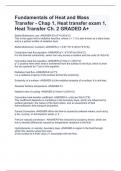
-
Fundamentals of Heat and Mass Transfer - Chap 1, Heat transfer exam 1, Heat Transfer Ch. 2 GRADED A+
- Exam (elaborations) • 9 pages • 2024
-
- $9.49
- + learn more
Fundamentals of Heat and Mass Transfer - Chap 1, Heat transfer exam 1, Heat Transfer Ch. 2 GRADED A+ Stefan-Boltzmann Law -ANSWER-E=σT^4 (W/m^2) This is the upper limit of radiative heat flux, where ε = 1. It is also known as a black body and is a perfect emitter of radiation heat. Stefan-Boltzmann Constant -ANSWER-σ = 5.67*10^-8 (W/(m^2*K^4)) Conductive heat flux equation -ANSWER-q''= -k*A*dT/dx (W/m^2) k is the thermal conductivity, which can vary across a medium and has units o...
![KTG[KINETIC THEORY OF GASES]THERMODYNAMICS](/docpics/5708377/66799f43ed3c8_5708377_121_171.jpeg)
-
KTG[KINETIC THEORY OF GASES]THERMODYNAMICS
- Class notes • 4 pages • 2024
-
- $14.49
- + learn more
Providing class notes of grade 11th Physics chapter that is kinetic theory of gases.Assumes that molecules are very small relative to the distance between molecule.The molecules are in constant,random motion and frequently collide with each other and with the walls of any container,Basically this chapter tells whole things about the nature of gases.And we studied the gas laws,graps,ideal gas equation,boltzmann constant.
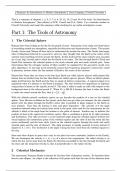
-
Summary Stellar Astrophysics
- Summary • 6 pages • 2024
-
- $5.98
- + learn more
Stellar Astrophysics. This is a summary of the the book "An Modern Introduction to Stellar Astrophysics" by Dale. A. Ostlie and Bradley W. Carroll. This summary contains the most important knowledge and equations from chapters 1, 2, 3, 5, 7, 8, 9, 10, 12, 13, 15 and 16. Included are the laws of motion (Kepler's Laws), the behaviour of light, het Boltzmann and Saha equation, the description of the interior of stars, stellar evolution and much more stuff. Especially on the first half of this su...
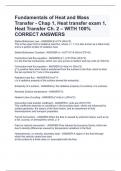
-
Fundamentals of Heat and Mass Transfer - Chap 1, Heat transfer exam 1, Heat Transfer Ch. 2 – WITH 100% CORRECT ANSWERS
- Exam (elaborations) • 9 pages • 2024
-
- $8.99
- + learn more
Fundamentals of Heat and Mass Transfer - Chap 1, Heat transfer exam 1, Heat Transfer Ch. 2 – WITH 100% CORRECT ANSWERS Stefan-Boltzmann Law - ANSWER-E=σT^4 (W/m^2) This is the upper limit of radiative heat flux, where ε = 1. It is also known as a black body and is a perfect emitter of radiation heat. Stefan-Boltzmann Constant - ANSWER-σ = 5.67*10^-8 (W/(m^2*K^4)) Conductive heat flux equation - ANSWER-q''= -k*A*dT/dx (W/m^2) k is the thermal conductivity, which can vary across...

Study stress? For sellers on Stuvia, these are actually golden times. KA-CHING! Earn from your study resources too and start uploading now. Discover all about earning on Stuvia


